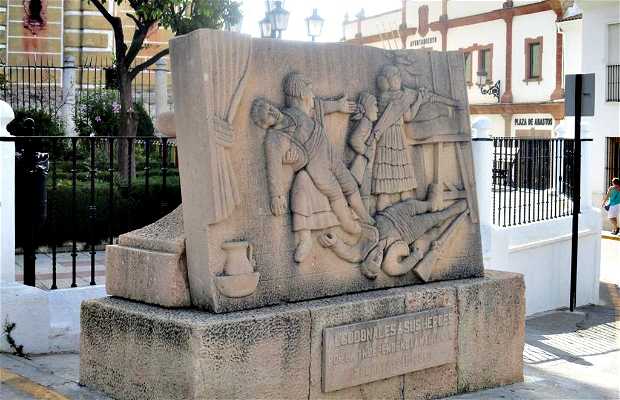El Viajero
I remember the story itself
Recuerdo de la propia historia
En el centro de Algodonales, delante de la iglesia de Santa Ana, se instaló en el año 2011 un monumento que evoca una antigua historia de la localidad.
En llegando las tropas francesas el 1 de mayo de 1810 a la zona exigieron a las localidades cercanas su inmediata rendición. Algodonales, por entonces barriada de Montellano, respondió disparando contra los franceses enarbolando una bandera roja en el campanario de la iglesia. La respuesta francesa fue a sangre y fuego, fueron casa por casa matando a sus habitantes, robando las viandas y prendiéndoles fuego. El pueblo respondió a tiros causando muchas bajas a los invasores, con una fiereza tal que hizo falta que todas las tropas napoleónicas de los entornos se concentraran en esta pequeña localidad.
Las mujeres se escondieron en las huertas cercanas y cayeron fácilmente en la lascivia de los soldados, pero os hombres tuvieron que ser abatidos por la fuerza de las armas. La batalla se prolongó dos días, al final de los cuales apenas resistían unas pocas casas como la de José Romero, alcalde de Montellano, y que se encontraba en el pueblo. Un centenar de jóvenes escaparon a la matanza, liderados por Gaspar Tarrío, y se convirtieron en el terror de la sierra.
Apenas quedaron de la población un centenar y medio de habitantes que iban a ser fusilados en Ronda al día siguiente, pero la intervención de un enviado real francés convenció al general Maransin para que evitase continuar la barbaridad.
Como consecuencia de la resistencia numantina a la ocupación francesa en 1967 se colocó una lápida en la casa quemada donde murió José Romero. Ya en 1817 las autoridades civiles determinaron premiar la lucha nombrando villa a Algodonales y dotándola de ayuntamiento y entidad propia. Por cierto el escudo municipal también evoca aquel exterminio, es una casa quemada.
Y, finalmente, en el 2011 se instaló este bajorrelieve evocando la lucha de aquellos héroes que prefirieron morir antes que rendirse.
A veces una simple piedra grabada inmortaliza hechos que en estos tiempos modernos nos parecen aberrantes pero que hace no demasiado demostraron el amor por su tierra de los habitantes de esta localidad. Dieron su vida por ser libres, libres vivieron y libres murieron.
In the center of Algodonales in front of the church of Santa Ana, he was installed in 2011 a monument that evokes an ancient history of the town. In reaching the French troops on May 1, 1810 to the area they demanded the immediate surrender nearby destinations. Algodonales, then a neighborhood of Montellano, responded by firing against the French waving a red flag in the steeple of the church. The French response was blood and fire, went house to house killing its inhabitants, stealing meats and setting them on fire. The people responded to shots causing many casualties on the invaders with a fierceness that it took all environments Napoleonic troops concentrate in this small town. Women hid in nearby orchards and easily fell into lasciviousness of the soldiers, but you men had to be killed by the force of arms. The battle lasted two days, at the end of which only a few houses resisted like Jose Romero, mayor of Montellano, and that was in the village. One hundred young people escaped the massacre, led by Gaspar Tarrío, and became the terror of the saw. As soon as they were of the population one hundred and fifty people who were to be shot in Ronda the next day, but the intervention of a French royal envoy convinced General Maransin to continue the barbarity avoided. As a result of the stubborn resistance to the French occupation in 1967 a plaque was placed in the burned house where he died Jose Romero. Already in 1817 the civil authorities determined struggle reward naming and endowing villa Algodonales Town Hall and its own entity. Certainly the municipal coat of arms also evokes that extermination is a burnt house. And finally, in 2011 this bas-relief was installed evoking the struggle of those heroes who preferred to die rather than surrender. Sometimes a simple stone immortalizes events recorded in these modern times we seem abhorrent but that is not too showed love for their land of the inhabitants of this town. They gave their lives to be free, free free lived and died.



